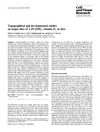In Vivo Microautoradiography of [3H]1,24(OH)2D3 (Tacalcitol) Following Topical Application to Normal Rats and In Vitro Metabolism in Human Keratinocytes
April 1996
in “
Archives of dermatological research
”
TLDR Topical tacalcitol can treat psoriasis by acting directly on skin cells.
This study investigated the absorption and metabolism of [3H]1,24(OH)2D3 (tacalcitol) in rats and human keratinocytes. After topical application to rat skin, high concentrations of the radiolabel were found in the stratum corneum, epidermis, and hair follicles, persisting up to 24 hours. Two absorption routes were identified: through the stratum corneum and epidermis into microvessels, and through hair follicles into the bloodstream, with approximately 30% of the applied radioactivity absorbed and excreted mainly via feces. In human keratinocytes, 1,24(OH)2D3 was not metabolized into other compounds, suggesting its direct action on epidermal keratinocytes. These findings indicated that topical 1,24(OH)2D3 could potentially treat psoriasis and other skin diseases by acting on the 1,25(OH)2D3 receptor, which regulates keratinocyte proliferation and differentiation.


